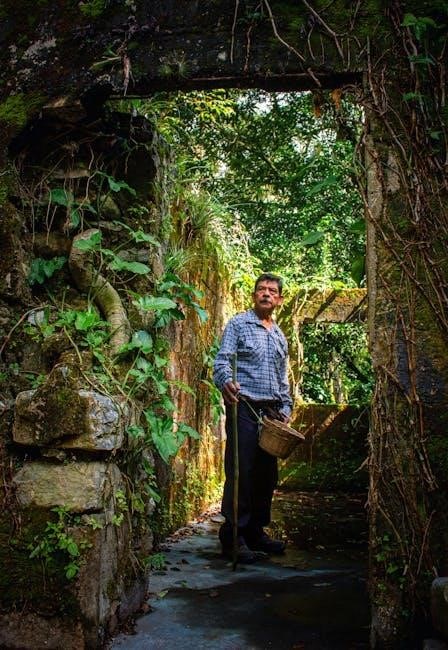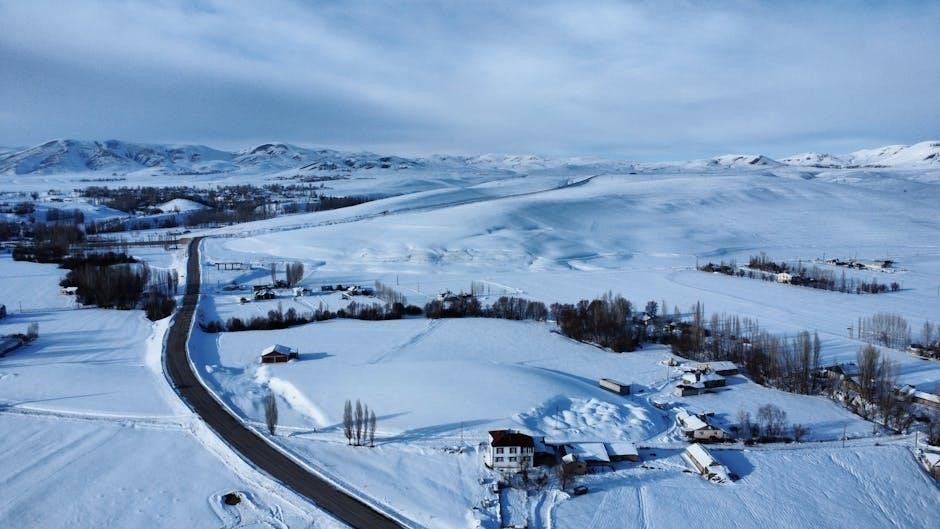Crafting a Minecraft village is an inspiring endeavor‚ demanding strategic planning and creative execution. This guide offers valuable tips‚ tricks‚ and even a secret or two‚ helping you navigate the game’s intricacies. Discover how to establish and flourish in this block-building world.
Planning Your Village
Before embarking on your village creation‚ careful planning is essential. Consider the village’s purpose‚ desired style‚ and available resources. A well-thought-out design will streamline the building process‚ ensuring a functional and aesthetically pleasing settlement. Establish a grid or radial layout for efficient navigation.
Choosing a Location
Selecting the perfect location is paramount for your Minecraft village‘s success. Consider various factors to ensure its long-term viability and aesthetic appeal. First‚ assess the surrounding environment. A location near essential resources like forests‚ water sources‚ and plains will greatly aid in resource gathering and farming.
Furthermore‚ evaluate the terrain’s suitability. A relatively flat area simplifies building‚ but incorporating natural features like hills or rivers can add visual interest. Biome selection also plays a crucial role. Different biomes offer unique resources and environments‚ impacting your village’s theme and resource availability.
Finally‚ prioritize safety by considering proximity to dangerous mobs or hostile environments. Secure locations provide a safe haven for your villagers and allow for peaceful expansion. Ultimately‚ the ideal location balances resource accessibility‚ aesthetic appeal‚ and safety considerations‚ laying the foundation for a thriving village.
Village Layout Design
Designing your Minecraft village‘s layout is crucial for functionality and aesthetics. Start by considering the village’s purpose and the number of villagers it will house. A well-planned layout ensures efficient resource flow and villager movement. One approach is the grid layout‚ offering simplicity and ease of navigation with intersecting streets at right angles.
Alternatively‚ the radial layout creates a visually striking village with streets radiating from a central point. Consider incorporating key structures like a central fountain and marketplace to create a focal point. Ensure clear pathways connect essential areas such as housing‚ farms‚ and crafting zones.
Furthermore‚ plan for future expansion by leaving space for new buildings and infrastructure. Consider the natural terrain and integrate it into your design‚ creating a cohesive and visually appealing village. A well-designed layout enhances the village’s functionality‚ aesthetics‚ and overall appeal‚ creating a thriving and enjoyable environment for your villagers.

Essential Village Structures
A thriving Minecraft village requires essential structures to support its inhabitants. These include housing for villagers‚ farms for food production‚ and dedicated areas for crafting and storage. Each structure plays a vital role in the village’s functionality.
Housing for Villagers
Providing suitable housing is essential for a thriving Minecraft village. Each villager needs a bed‚ and ensuring enough beds are available will encourage breeding and population growth. Consider various house designs‚ from simple wooden huts to more elaborate structures‚ to add visual appeal to your village.
When designing villager houses‚ remember to include essential features like doors‚ windows‚ and a light source to prevent hostile mobs from spawning inside. You can also add decorative elements‚ such as flower pots‚ paintings‚ and carpets‚ to make each house feel more homely and inviting.
Experiment with different building materials to create a unique aesthetic for your village. Mix and match wood types‚ stone bricks‚ and other blocks to add texture and visual interest. Consider building houses with different sizes and shapes to create a more diverse and realistic village layout. Remember that a villager will claim a bed as its own‚ so ensure each house has enough beds for its intended occupants.
Well-designed villager housing contributes significantly to the overall atmosphere and functionality of your Minecraft village.
Farms and Food Production
Sustaining your Minecraft village requires efficient farms and reliable food production. Designate areas for growing crops like wheat‚ carrots‚ potatoes‚ and beetroot to ensure a steady food supply for your villagers. Employing villagers as farmers is crucial‚ as they will automatically plant and harvest crops‚ sharing food with other villagers‚ and promoting breeding.
Consider building different types of farms‚ such as automated farms using water streams and pistons‚ or more traditional manual farms with rows of crops. Don’t forget to provide a water source for irrigation and fences to protect your crops from trampling;
Animal husbandry is another essential aspect of food production. Build pens for livestock like cows‚ pigs‚ sheep‚ and chickens to provide meat‚ milk‚ and eggs. Ensure that animals have access to food and water and that their pens are securely fenced to prevent escapes. Remember that well-fed villagers are happy villagers‚ and a thriving food supply is the key to a prosperous village. Experiment with different farm layouts and automation techniques to optimize your food production and keep your villagers well-nourished.
Crafting and Storage Areas
Every thriving Minecraft village needs dedicated spaces for crafting essential items and storing valuable resources. Designate a specific area for crafting tables‚ furnaces‚ anvils‚ and other crafting stations. This central crafting hub will streamline production and make it easier for villagers and players alike to access necessary tools and materials.
Efficient storage is equally important. Implement a well-organized storage system using chests‚ barrels‚ and other storage containers. Label each container clearly to indicate its contents‚ making it easy to find specific items when needed. Consider building a dedicated storage building or integrating storage areas into individual villager houses.
Optimize your crafting and storage areas by placing frequently used items and crafting stations within easy reach. Consider automating certain crafting processes using redstone contraptions to increase efficiency. A well-designed crafting and storage system will save time‚ reduce clutter‚ and contribute to the overall functionality and organization of your village‚ ensuring a smooth and productive gameplay experience.

Defense and Security
Protecting your Minecraft village is essential for its survival. Implement robust defenses to ward off hostile mobs. Building walls‚ gates‚ and employing hidden entrances will keep your base secret and secure‚ ensuring the safety of your villagers.
Building Walls and Gates
Constructing walls is the first line of defense for your Minecraft village. Choose durable materials like cobblestone‚ stone bricks‚ or even obsidian for enhanced protection. Consider the height of your walls to prevent mobs from jumping over. A height of at least three blocks is generally recommended.
Strategically place towers along the walls to provide vantage points for archers or players to defend against incoming threats. Incorporate battlements or overhangs to increase defensive capabilities. Gates are crucial for controlled access to the village;
Use iron doors or wooden doors reinforced with iron bars for added security. Implement redstone mechanisms to automatically open and close the gates‚ ensuring swift and efficient defense during nighttime sieges. Consider adding a moat around the walls to further deter enemies from reaching your village.
Creating Hidden Entrances
Concealed entrances are invaluable for safeguarding your Minecraft village and its resources. One approach involves using a waterfall as a camouflage. Build your entrance behind the cascading water‚ creating a secret passage only accessible by swimming through the falls.
Another technique utilizes a seemingly ordinary tree. Integrate a piston mechanism that‚ when activated‚ reveals a hidden doorway within the tree’s base. Alternatively‚ employ a bookshelf in a library or a painting in a storage room as a lever to unlock a secret passage.
Camouflage the entrance with blocks that blend seamlessly with the surrounding environment. Utilize redstone contraptions to create pressure plate-activated doorways hidden beneath carpets or trapdoors disguised as part of the landscape. The key is to make the entrance virtually undetectable to unsuspecting eyes‚ ensuring the safety and privacy of your village.

Aesthetic Enhancements
Elevate your Minecraft village beyond functionality by incorporating aesthetic elements. Custom paths‚ decorative features‚ and thoughtful landscaping will transform a practical settlement into a visually appealing and immersive environment‚ captivating both residents and visitors alike with its charm.
Custom Paths and Landscaping
Once the essential structures are in place‚ focus on the details that bring your Minecraft village to life. Custom paths are a fantastic way to add character and guide villagers and players through the settlement. Experiment with various materials like cobblestone‚ gravel‚ and wood planks to create visually appealing routes. Varying path widths and incorporating gentle curves can further enhance the natural feel.
Landscaping is crucial for integrating your village into the surrounding environment. Consider adding custom trees‚ flower gardens‚ and small ponds to create a more inviting atmosphere. Terraforming the terrain around your structures can also blend the village seamlessly with the landscape. Use bone meal on grass blocks to encourage flower growth‚ or plant saplings to cultivate forests.
Remember to consider the natural environment when creating a custom village. These secret entrances will keep your Minecraft base secret and…
Adding Decorative Elements
The final touch in creating a truly unique Minecraft village lies in the details. Adding decorative elements can transform a functional settlement into a visually stunning masterpiece. Consider incorporating banners with custom designs to represent your village‘s identity. These can be hung from buildings or placed along pathways to add color and flair.
Lighting is also essential for both aesthetics and functionality. Use lanterns‚ torches‚ and glowstone to illuminate streets and buildings‚ creating a warm and inviting atmosphere. Strategically placed lighting can also deter hostile mobs from spawning within the village.
Small details like flower pots‚ window boxes‚ and custom furniture can add a touch of realism to your structures. Experiment with different block combinations to create unique designs that reflect your personal style. Don’t be afraid to get creative and add unexpected elements to surprise and delight visitors. The possibilities are limitless.

Advanced Building Techniques
Once you’ve mastered the basics of Minecraft village construction‚ it’s time to explore advanced building techniques. One such technique is the use of the clone command‚ which allows you to quickly duplicate structures‚ saving time and effort when creating multiple identical buildings.
Another advanced technique is terraforming‚ which involves reshaping the landscape to better suit your village design. This can include creating hills‚ valleys‚ and rivers to add depth and visual interest to the surrounding environment.
For those looking to add a touch of intrigue‚ consider incorporating hidden entrances and secret passages into your buildings. These can be concealed behind bookshelves‚ paintings‚ or even within the walls themselves. This adds an element of surprise and discovery for visitors.
Finally‚ experiment with different building styles and materials to create a unique and cohesive aesthetic. Don’t be afraid to push the boundaries of your creativity.